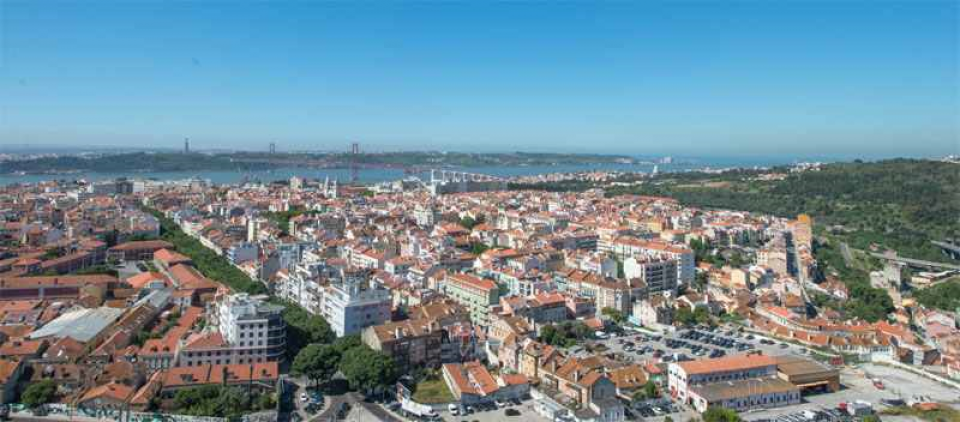
- Enhancing sustainable urbanization
- Restoring ecosystems and their functions
- Developing climate change mitigation
- Developing climate change adaptation; improving risk management and resilience
Over the last few decades, Lisbon has lost a third of its residents (Green Surge: Lisbon case study) as a result of uncontrolled urban development (urban sprawl in the suburbs coupled with depopulation and decaying neighbourhoods in the historical centre). This has led to a deterioration of the quality of life in the city. It is currently facing challenges such as the ‘heat island effect’, floods, air pollution and unequal distribution of green spaces.
The city administration has invested in the regeneration of the city, bearing in mind the importance of the environment and people’s wellbeing. This regeneration is part of the city's strategy to enhance its tourism potential and attractiveness.
To tackle these challenges, the city has taken a series of measures in the context of the Master Development Plan. The plan sets out guidelines and objectives for specific planning and local development. In particular, the municipal ecological structure takes into account ecological principles and the importance of preserving natural, forest, agricultural and cultural heritage. Together with the Biodiversity 2020 Strategy, the city also approved the Biodiversity Action Plan in 2016, putting implementation actions in the context of green infrastructure and climate change adaptation and mitigation.
Connecting green spaces by creating green corridors has been one of the main priorities. The best example is the Main Green Corridor, connecting Monsanto Forest Park to the city centre through Eduardo VII Park. Furthermore, the Eixo Central revamping project, currently being developed, shows how planting street trees and making green areas can create synergies and improve existing grey infrastructure. This helps reduce traffic, giving pedestrians and cyclists more space. Greening these infrastructures makes better ecological connections possible and contributes to air pollution control. Street trees make the city more attractive, better connect green spaces and provide shade for cyclists. As part of its Green Plan (2008), Lisbon also set up a working group to promote and enhance urban agriculture, emphasized in the Biodiversity 2020 Strategy.
While these measures have been planned separately at different times, taken together, they can be seen to have clearly enabled synergies in tackling a series of social challenges by providing key ecosystem services.
Thus, even if not explicitly following a systemic NbS approach from the outset, the cumulative effect of these measures is greater than merely a series of individual projects.
|
Objectives /Theme |
Enhancing sustainable urbanisation |
Restoring ecosystems and their functions |
Developing climate change mitigation |
Developing climate change adaptation; improving risk management and resilience |
|
Green Corridors |
Enhancing city attractiveness; Regulating air quality; Increasing property value; Offering recreation and a healthy lifestyle |
Creating and improving ecosystems and connections |
CO2 sequestration; Bicycle and Pedestrian mobility; Enhancing soil protection with CO2 and NO2 sinking |
Maintaining humidity, lowering temperatures; Reducing stormwater runoff and ground drainage |
|
Street Trees |
Enhancing city attractiveness; Regulating air quality; Increasing property value |
Creating and improving ecosystems and connections |
CO2 sequestration; Energy saving |
Reducing stormwater runoff; Lowering temperatures |
|
Urban Agriculture |
Offering recreation and a healthy lifestyle; Re-use of abandoned areas |
Promoting ecological balance of the territory |
CO2 sequestration; Local Food Production |
Maintaining humidity, lowering temperatures; Reducing stormwater runoff and ground drainage |
The Polis projects have since replicated this experience in other urban areas in Portugal, providing cities with regenerated spaces, a better environment and better quality of life. These projects helped mainstream the idea that a healthy environment and urban regeneration have to complement each other in innovative ways. The case of Lisbon also shows that even during a financial crisis a city can improve its citizens' wellbeing and its ecological structure with small-scale, concerted measures that are relatively cheap to implement.
In the 1998 World Exhibition, the city of Lisbon promoted the regeneration of its eastern waterfront, today known as Parque das Nações. Previously an obsolete industrial area, with contaminated soil, today the area boasts 110 ha of green spaces, real estate, business centres and modern transport connections. Although it did not adopt an NbS approach from the beginning, the project made it possible to regenerate an obsolete and contaminated area through sustainable urbanisation, with the emphasis on green spaces. The project made better connections with Lisbon's ecological structure possible, as well as pollution control and monitoring. It has also made it possible to requalify the Tagus river salt marshes, focusing on biodiversity conservation and monitoring (especially migratory birds). This in turn created new opportunities for birdwatching tourism.
Financing
The most common ways of financing the implementation of nature-based measures are:
- the municipal budget (general);
- municipal budget, decided on through participatory budget voting;
- European funds (mostly structural and cohesion funds 2007-2013);
- Lisbon´s Casino direct funding obligations;
- partnerships with private companies resulting from municipal taxation and charges for permission to use public space during occasional events or as direct compensation from services that require municipal authorisation;
- sponsorship from national and private companies.
Success and limiting factors
The urban regeneration measures taken so far have shown how the restoration of Lisbon’s historical quarters and its riverfront, using nature-based solutions, helps both to improve the wellbeing of its inhabitants and make the city more attractive.
The Riverfront General Plan, being implemented since 2008 (see Figure 5) has been promoting regeneration of the riverfront based on environmental concerns, making Lisbon more competitive as a welcoming city for people and investments. It includes measures for the integration into the city’s ecological structure (further connection with other green areas and corridors in the city, as well as the city's drainage plan for flood control). It creates a diverse range of leisure and sports activities, joining the new urban spaces with the river and protecting the city from rising sea water levels due to climate change (Lisbon: a new relationship with the river).
